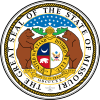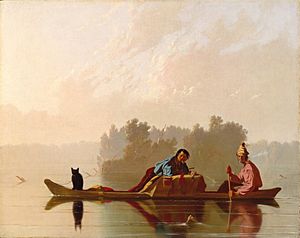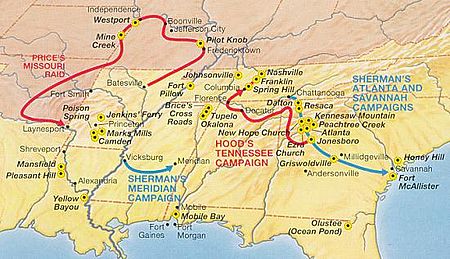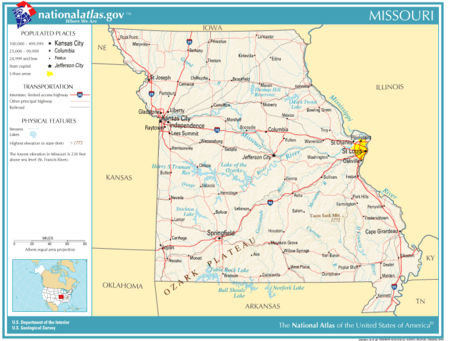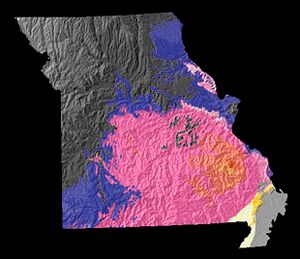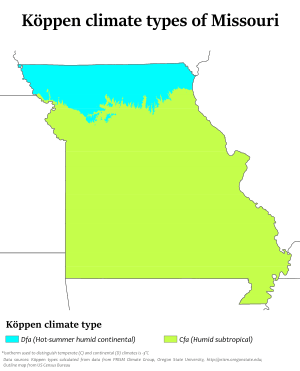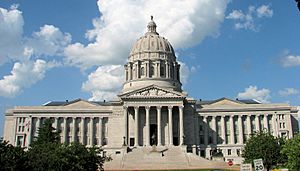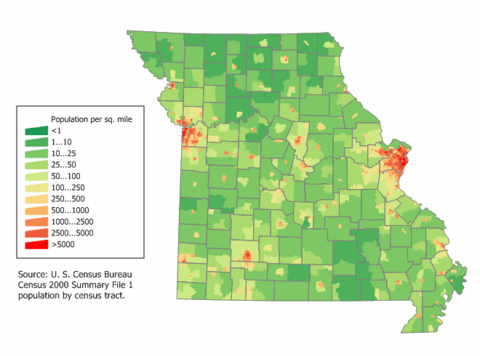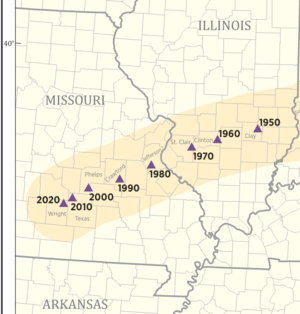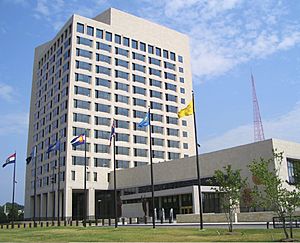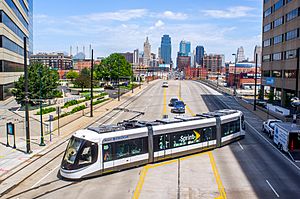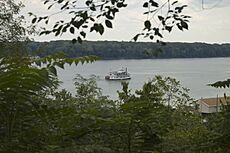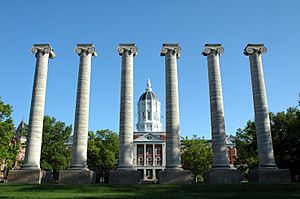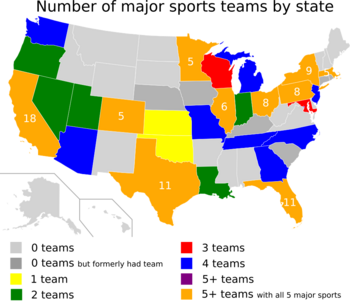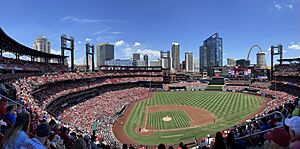Missouri facts for kids
Quick facts for kids
Missouri
|
|||
|---|---|---|---|
|
|||
| Nicknames:
Show Me State, Cave State, and Mother of the West
|
|||
| Motto(s):
Salus populi suprema lex esto (Latin) Let the good of the people be the supreme law
|
|||
| Anthem: "Missouri Waltz" | |||
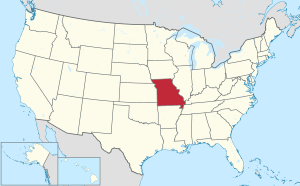
Location of Missouri within the United States
|
|||
| Country | United States | ||
| Before statehood | Missouri Territory | ||
| Admitted to the Union | August 10, 1821 (24th) | ||
| Capital | Jefferson City | ||
| Largest city | Kansas City | ||
| Largest county or equivalent | St. Louis | ||
| Largest metro and urban areas | Greater St. Louis | ||
| Legislature | General Assembly | ||
| • Upper house | Senate | ||
| • Lower house | House of Representatives | ||
| Judiciary | Supreme Court of Missouri | ||
| U.S. senators | Josh Hawley (R) Eric Schmitt (R) |
||
| U.S. House delegation | 6 Republicans 2 Democrats (list) |
||
| Area | |||
| • Total | 69,715 sq mi (180,560 km2) | ||
| • Land | 68,886 sq mi (179,015 km2) | ||
| Area rank | 21st | ||
| Dimensions | |||
| • Length | 300 mi (480 km) | ||
| • Width | 240 mi (390 km) | ||
| Elevation | 800 ft (244 m) | ||
| Highest elevation | 1,772 ft (540 m) | ||
| Lowest elevation
(St. Francis River at Arkansas border)
|
230 ft (70 m) | ||
| Population
(2024)
|
|||
| • Total | |||
| • Rank | 19th | ||
| • Density | 88.2/sq mi (34.1/km2) | ||
| • Density rank | 30th | ||
| • Median household income | $68,500 (2023) | ||
| • Income rank | 38th | ||
| Demonym(s) | Missourian | ||
| Language | |||
| • Official language | English | ||
| • Spoken language |
|
||
| Time zone | UTC−06:00 (Central) | ||
| • Summer (DST) | UTC−05:00 (CDT) | ||
| USPS abbreviation |
MO
|
||
| ISO 3166 code | US-MO | ||
| Traditional abbreviation | Mo. | ||
| Latitude | 36° 0′ N to 40° 37′ N | ||
| Longitude | 89° 6′ W to 95° 46′ W | ||
| Song | Missouri Waltz |
|---|---|
| Dance | Square dance |
| Bird | Eastern bluebird |
| Fish | Channel catfish |
| Flower | White hawthorn |
| Fruit | Paw-paw |
| Tree | Flowering Dogwood |
| Insect | Western honey bee |
Missouri is a state located in the Midwestern part of the United States. It is the 21st largest state by land area. Missouri shares borders with eight other states. These include Iowa to the north, Illinois, Kentucky, and Tennessee to the east. To the south, it borders Arkansas, and to the west, it borders Oklahoma, Kansas, and Nebraska.
The southern part of Missouri is home to the Ozarks, a beautiful forested highland. This area provides timber, minerals, and many places for outdoor fun. The St. Francois Mountains in Missouri are incredibly old, about 1.5 billion years old! The Missouri River, which gives the state its name, flows through the middle of the state. It then joins the Mississippi River, which forms Missouri's eastern border.
With over six million people, Missouri is the 19th most populated state in the U.S. Its biggest cities are St. Louis, Kansas City, Springfield, and Columbia. The state capital is Jefferson City.
People have lived in what is now Missouri for at least 12,000 years. The Mississippian culture built large cities and mounds here, starting in the 800s. These civilizations faded by the 1300s. When Europeans arrived in the 1600s, the Osage and Missouria Native American groups lived in the area.
The French claimed this land as part of Louisiana. They founded Ste. Genevieve in 1735 and St. Louis in 1764. After a short time under Spanish rule, the United States bought Missouri in 1803 as part of the Louisiana Purchase. Many Americans moved to the new Missouri Territory, and Missouri became a key starting point for westward expansion.
Missouri joined the U.S. as a state in 1821, as part of the Missouri Compromise. During the American Civil War, Missouri was a border state. This meant it had complex loyalties, with some supporting the Union and others the Confederacy. After the war, both Greater St. Louis and the Kansas City metropolitan area grew into major industrial and business centers.
Today, Missouri has 114 counties and the independent city of St. Louis. It is known by nicknames like the "Mother of the West," the "Cave State," and the "Show Me State." Missouri's culture is a mix of Midwestern and Southern influences. It is the birthplace of music styles like ragtime, Kansas City jazz, and St. Louis blues. You can also find famous Kansas City-style barbecue and St. Louis-style barbecue here.
Missouri is a big center for brewing beer. It is home to Anheuser-Busch, one of the world's largest beer companies. The state also produces Missouri wine, especially in the Missouri Rhineland area. Outside the big cities, popular places to visit include the Lake of the Ozarks, Table Rock Lake, and Branson. Some large companies based in Missouri include Cerner, Express Scripts, Emerson Electric, and O'Reilly Auto Parts. Important universities include the University of Missouri, Saint Louis University, and Washington University in St. Louis.
Contents
- What's in a Name? Etymology and Pronunciation
- Missouri's Past: A Brief History
- Missouri's Landscape: Geography and Climate
- How Missouri is Governed
- People of Missouri: Demographics
- Missouri's Economy
- Getting Around: Transportation in Missouri
- Cities and Towns in Missouri
- Learning in Missouri: Education
- Missouri's Culture
- See also
What's in a Name? Etymology and Pronunciation
The state of Missouri gets its name from the Missouri River. The river was named after the Missouria, a Native American tribe. This tribe spoke a Siouan language. French colonists heard their name as Wimihsoorita, which means "One who has dugout canoes."
The name Missouri can be pronounced in a few different ways, even by people who live there! The two most common ways are mih-ZUR-ee and mih-ZUR-ə. No single pronunciation is considered the "correct" one. Sometimes, people even write the name as "Missour-ee" or "Missour-uh" to show how it sounds.
Missouri's Popular Nicknames
Missouri does not have an official state nickname. However, its most famous unofficial nickname is the "Show Me State." You can even see this phrase on Missouri's license plates.
There are a few stories about how this nickname started. One popular story says it came from a speech by Congressman Willard Vandiver in 1899. He supposedly said, "I'm from Missouri, and you have got to show me." This phrase means "I'm not easily convinced; you need to prove it to me." However, researchers say the phrase was used even before the 1890s. Another idea is that it refers to Missouri miners who went to Colorado. They needed frequent instructions because they were new to the mining methods there.
Other nicknames for Missouri include "The Lead State" and "The Cave State." It's called the "Cave State" because it has over 7,300 recorded caves! Only Tennessee has more. Perry County has the most caves and the longest single cave in the state.
Missouri's official state motto is a Latin phrase: "Salus Populi Suprema Lex Esto." This means "Let the welfare of the people be the supreme law."
Missouri's Past: A Brief History
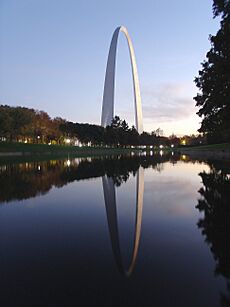
Early Inhabitants and European Arrival
Evidence from archaeological digs shows that people have lived in Missouri's river valleys since about 9000 BCE. Around 1000 CE, the Mississippian culture built large cities and earthwork mounds in places like present-day St. Louis. These mounds were used for religious, political, and social reasons. Cahokia, across the river in Illinois, was a major trading center. This civilization declined by 1400 CE.
When French traders and missionaries explored the Mississippi Valley in the 1700s, they called the region "Louisiana." The first European settlers in Missouri were mostly French Canadians. They started the settlement of Ste. Genevieve around 1750. These early towns used enslaved African and Native American people for farming and the fur trade. Ste. Genevieve became a successful farming area, sending crops like wheat and corn downriver.
St. Louis was founded in 1764 by French fur traders. From 1764 to 1803, Spain controlled the area west of the Mississippi River. St. Louis became a major center for the fur trade, which was very important to the economy. The city grew even more after the invention of the steamboat, which made river trade easier.
Becoming a State: The 1800s
In 1803, the United States bought Louisiana from France in the Louisiana Purchase. Missouri became known as the Gateway to the West because it was a key starting point for explorers and settlers heading west. The famous Lewis and Clark Expedition began in St. Charles in 1804.
Many early settlers in western Missouri came from the Southern U.S. They brought enslaved African Americans with them to work on farms. These settlers mostly lived in 17 counties along the Missouri River, an area known as "Little Dixie."
Missouri became a state in 1821, joining as a state where slavery was allowed. The first temporary capital was St. Charles. In 1826, the capital moved to its permanent location, Jefferson City.
In the 1830s, Mormon settlers moved to Missouri. Differences in religion and views on slavery led to conflicts. By 1839, the Mormons were forced to leave Missouri.
From the 1830s to the 1860s, Missouri's population nearly doubled each decade. Many new people were from other parts of America, but Irish and German immigrants also arrived. German immigrants helped create the wine industry along the Missouri River and the beer industry in St. Louis.
Missouri During the American Civil War
When Southern states started leaving the Union in 1861, Missouri faced a difficult choice. The state convention voted against leaving the Union. However, the governor, Claiborne F. Jackson, supported the Confederacy. He tried to get Confederate weapons for the state militia. Union General Nathaniel Lyon quickly stopped this. This led to a riot in St. Louis, which further divided the state.
Governor Jackson and his supporters fled the capital. The state convention then appointed Hamilton Gamble as the new governor, and President Lincoln recognized his government. This allowed Missouri to raise troops for the Union Army.
Fighting continued in Missouri, often as guerrilla warfare. Groups like those led by William Quantrill and the James-Younger gang used quick, small attacks. The stories of the James brothers became a kind of "Robin Hood" myth in America.
The 1900s and Beyond
Between the Civil War and the end of World War II, Missouri changed from a farming economy to one with more factories and services. The growth of railroads made Kansas City a major transportation center. It also became a big meatpacking hub, as cattle were brought there by train to be processed.
In the mid-1900s, St. Louis and Kansas City lost some factory and railroad jobs. Like other Midwestern cities, they had to adapt. New highways made it easy for people to move to the suburbs. Today, both Kansas City and St. Louis are seeing their downtown areas grow and improve with new buildings and projects.
Missouri's Landscape: Geography and Climate
Missouri borders eight different states, which is a lot! Only Tennessee borders as many. To the north, it borders Iowa. To the east, across the Mississippi River, are Illinois, Kentucky, and Tennessee. To the south is Arkansas. To the west, it borders Oklahoma, Kansas, and Nebraska.
The two largest rivers are the Mississippi River, which forms the eastern border, and the Missouri River, which flows through the state from west to east. These rivers connect the two biggest cities, Kansas City and St. Louis.
Historically, Missouri was seen as a "border state" because many settlers came from the South and brought the practice of slavery. However, today it is usually considered part of the Midwest.
Missouri's Land Features
North of the Missouri River, the land is mostly rolling hills, like the Great Plains. These hills were shaped by glaciation long ago. Missouri also has many tall cliffs, called bluffs, along its major rivers.
Southern Missouri is home to the Ozark Mountains. This area has lots of karst topography, meaning it has many sinkholes and caves because of the limestone in the ground.

The southeastern part of the state is called the Missouri Bootheel. This area is the lowest, flattest, warmest, and wettest part of Missouri. It is very fertile, and crops like cotton and rice are grown there. The Bootheel was the center of the powerful New Madrid Earthquakes in 1811 and 1812.
Missouri's Weather and Climate
Missouri generally has a humid continental climate. This means it has cool or cold winters and hot, humid, and wet summers. In the southern part of the state, especially the Bootheel, the climate is more humid subtropical.
Because Missouri is in the middle of the U.S., it often has extreme temperatures. There are no big mountains or oceans nearby to make the weather milder. So, the climate is affected by cold air from the Arctic and hot, humid air from the Gulf of Mexico.
Missouri is in Tornado Alley, so it often experiences severe thunderstorms and tornadoes. On May 22, 2011, a very strong tornado hit Joplin. It killed 158 people and destroyed about one-third of the city. This tornado caused a lot of damage and was one of the deadliest in U.S. history. St. Louis and its suburbs have also been hit by severe tornadoes in the past.
| Monthly normal high and low temperatures for various Missouri cities in °F (°C). | |||||||||||||||
| City | Avg. | Jan | Feb | Mar | Apr | May | Jun | Jul | Aug | Sep | Oct | Nov | Dec | Year | |
|---|---|---|---|---|---|---|---|---|---|---|---|---|---|---|---|
| Columbia | High | 37 (3) |
44 (7) |
55 (13) |
66 (19) |
75 (24) |
84 (29) |
89 (32) |
87 (31) |
79 (26) |
68 (20) |
53 (12) |
42 (6) |
65.0 (18.3) |
|
| Columbia | Low | 18 (−8) |
23 (−5) |
33 (1) |
43 (6) |
53 (12) |
62 (17) |
66 (19) |
64 (18) |
55 (13) |
44 (7) |
33 (1) |
22 (−6) |
43.0 (6.1) |
|
| Kansas City | High | 36 (2) |
43 (6) |
54 (12) |
65 (18) |
75 (24) |
84 (29) |
89 (32) |
87 (31) |
79 (26) |
68 (20) |
52 (11) |
40 (4) |
64.4 (18.0) |
|
| Kansas City | Low | 18 (−8) |
23 (−5) |
33 (1) |
44 (7) |
54 (12) |
63 (17) |
68 (20) |
66 (19) |
57 (14) |
46 (8) |
33 (1) |
22 (−6) |
44.0 (6.7) |
|
| Springfield | High | 42 (6) |
48 (9) |
58 (14) |
68 (20) |
76 (24) |
85 (29) |
90 (32) |
90 (32) |
81 (27) |
71 (22) |
56 (13) |
46 (8) |
67.6 (19.8) |
|
| Springfield | Low | 22 (−6) |
26 (−3) |
35 (2) |
44 (7) |
53 (12) |
62 (17) |
67 (19) |
66 (19) |
57 (14) |
46 (8) |
35 (2) |
26 (−3) |
45.0 (7.2) |
|
| St. Louis | High | 40 (4) |
45 (7) |
56 (13) |
67 (19) |
76 (24) |
85 (29) |
89 (32) |
88 (31) |
80 (27) |
69 (21) |
56 (13) |
43 (6) |
66.2 (19.0) |
|
| St. Louis | Low | 24 (−4) |
28 (−2) |
37 (3) |
47 (8) |
57 (14) |
67 (19) |
71 (22) |
69 (21) |
61 (16) |
49 (9) |
38 (3) |
27 (−3) |
48.0 (8.9) |
|
| Source: | |||||||||||||||

Missouri's Wildlife and Forests
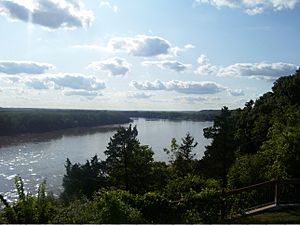
Missouri has a wide variety of flora (plants) and fauna (animals). Many different species live here. The state has a lot of fresh water from the Mississippi River, Missouri River, Table Rock Lake, and Lake of the Ozarks, plus many smaller rivers and lakes.
North of the Missouri River, the land is mostly rolling hills with Great Plains plants. South of the Missouri River, the state is covered by Oak-Hickory forests.
After World War II, people started using public forests more for recreation like hiking and camping. This led to efforts to protect these areas. The Wilderness Act of 1964 helped set aside "wilderness areas" where nature is preserved. This included forests like the Mark Twain National Forest.
How Missouri is Governed
Missouri's government is set up by its constitution, adopted in 1945. It has three main parts:
- The legislative branch makes laws. It includes the House of Representatives and the Senate, which together form the Missouri General Assembly.
- The judicial branch interprets laws. It includes the Supreme Court of Missouri and other courts.
- The executive branch carries out laws. It is led by the Governor of Missouri and other elected officials.
Harry S Truman (1884–1972), who became the 33rd President of the United States, was born in Lamar. He lived in Missouri for most of his life.
People of Missouri: Demographics
In 2019, Missouri had about 6.1 million people. More than half of Missourians live in the state's two largest metropolitan areas: St. Louis and Kansas City.
The largest ancestry groups in Missouri are:
African Americans make up a significant part of the population in St. Louis, Kansas City, and some areas along the Missouri River Valley. Kansas City has growing communities of immigrants from Latin America, Africa, and Southeast Asia.
Languages Spoken in Missouri
Most people in Missouri speak English. About 5.1% of the population speaks another language at home. Spanish is spoken in some Latino communities in St. Louis and Kansas City.
Missouri is also home to a very rare dialect of French called Missouri French. The people who speak it are descendants of early French settlers. This dialect is now almost gone, with only a few older speakers remaining.
Religion in Missouri
Religion in Missouri (2014) Protestantism (58%) Roman Catholicism (16%) Mormonism (1%) Other Christian (2%) No religion (20%) Buddhism (1%) Other religion (2%)
A study in 2014 found that 80% of Missourians identify with a religion. Most of these (77%) are Christians. The remaining 20% do not identify with a religion.
Several religious organizations have their main offices in Missouri. These include the Lutheran Church–Missouri Synod in Kirkwood and the United Pentecostal Church International in Hazelwood. Independence is a very important place for several branches of the Latter Day Saint movement. Springfield is known as a Christian center and is sometimes called a "buckle" of the Bible Belt.
Missouri's Economy
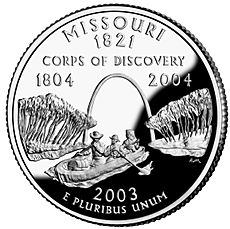
Missouri's economy is quite diverse. In 2023, the state's total economic output was about $422 billion. Major industries include aerospace, transportation equipment, food processing, chemicals, and financial services.
Agriculture is a big part of Missouri's economy. The state produces beef, soybeans, pork, dairy products, and corn. Missouri ranks high nationally for hog and cattle production. It is also a top state for soybean and rice production. In 2001, Missouri had the second-largest number of farms in any state, after Texas. The state's wine industry is also growing quickly.
Missouri has large amounts of limestone and is the top state for lead production. It also produces a lot of lime, which is used in cement.
Tourism is also important, thanks to Missouri's many rivers, lakes, caves, and parks. Popular spots include Gateway Arch National Park in St. Louis and the Ozark National Scenic Riverways. Meramec Caverns is a well-known show cave.
Missouri is unique because it is the only state with two Federal Reserve Banks: one in Kansas City and one in St. Louis. These banks help manage the nation's money supply.
Getting Around: Transportation in Missouri
Airports
Missouri has two main airports for travelers: St. Louis Lambert International Airport and Kansas City International Airport. In southern Missouri, the Springfield–Branson National Airport (SGF) offers many direct flights. People in central Missouri use Columbia Regional Airport (COU) for flights to major cities.
Rail Travel
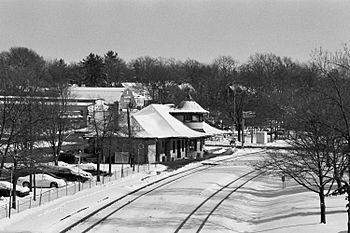
Missouri is a major hub for railroads. Kansas City is the second-largest freight rail center in the U.S. St. Louis is also a big destination for train freight.
Amtrak passenger trains serve many cities in Missouri, including Kansas City, St. Louis, and Jefferson City.
The only urban light rail system in Missouri is MetroLink in St. Louis, which connects the city to suburbs and even Illinois. Kansas City also has the KC Streetcar in its downtown area, which opened in 2016.
Bus Services
Many cities in Missouri have local bus systems. Greyhound and Trailways offer bus service between cities.
Rivers for Transport
Both the Mississippi River and the Missouri River are used for commercial shipping in Missouri. St. Louis is a major hub for barge traffic on the Mississippi.
Roads and Highways
Missouri has a large network of roads and highways. The Missouri Department of Transportation (MoDOT) works to keep highways in good condition. Traffic deaths have been decreasing over the years, showing safer roads.
Cities and Towns in Missouri
Jefferson City is the capital city of Missouri. The five largest cities in the state are Kansas City, St. Louis, Springfield, Columbia, and Independence.
St. Louis is the main city of Missouri's largest metropolitan area. This area includes 17 counties and the independent city of St. Louis. It is one of the largest metro areas in the U.S. Some major cities in the St. Louis metro area include O'Fallon, St. Charles, and Chesterfield.
Kansas City is Missouri's largest city. It is the main city of the Kansas City Metropolitan Area, which includes parts of Kansas. This is also one of the largest metro areas in the U.S. Other major cities in the Kansas City metro area include Independence, Lee's Summit, and Blue Springs.
Springfield is Missouri's third-largest city. It is the main city of the Springfield-Branson Metropolitan Area. Branson is a very popular tourist spot in the Ozarks.
Learning in Missouri: Education
Schools for Kids and Teens
The Missouri State Board of Education oversees all public education in Missouri. Kids must attend school from ages seven to seventeen. If a child between five and seven is enrolled in public school, they must attend regularly.
Missouri schools are usually divided into elementary school, middle school or junior high school, and high school. The public school system goes from kindergarten to 12th grade. Homeschooling is also allowed in Missouri.
Colleges and Universities
The University of Missouri System is the state's public university system. The biggest university is the University of Missouri in Columbia. Other universities in the system include University of Missouri–Kansas City, University of Missouri–St. Louis, and Missouri University of Science and Technology.
Missouri also has many private colleges and universities. Washington University in St. Louis and Saint Louis University are two highly-ranked private schools. There are also junior colleges and trade schools.

The state offers a scholarship called Bright Flight to top high school graduates who attend a university in Missouri.
There is a long-standing sports rivalry between the University of Missouri and the University of Kansas. This rivalry, known as the "Border War," was mainly seen in football and basketball games. Even though Missouri left the Big 12 Conference in 2012, the rivalry still exists.
Missouri's Culture
Music from Missouri
Many famous musicians were born or lived in Missouri. These include rock pioneer Chuck Berry, "Queen of Rock" Tina Turner, pop singer Sheryl Crow, and rappers Nelly and Akon.
Country singers like Sara Evans and Porter Wagoner are from Missouri. Ragtime composer Scott Joplin lived in St. Louis and Sedalia. Jazz saxophonist Charlie Parker lived in Kansas City.
The Kansas City Symphony and the St. Louis Symphony Orchestra are the state's main orchestras. The St. Louis Symphony is the second-oldest in the nation. Branson is famous for its many music theaters.
Literature and Authors

Missouri is the home state of Mark Twain. His famous novels, The Adventures of Tom Sawyer and The Adventures of Huckleberry Finn, are set in his childhood town of Hannibal. Other well-known authors from Missouri include Kate Chopin, T. S. Eliot, and Tennessee Williams.
Missouri on Film
Filmmaker Walt Disney spent part of his childhood in Marceline and started his artistic career in Kansas City.
Many movies have been filmed in Missouri. Film versions of Mark Twain's novels are often set here. The musical Meet Me in St. Louis is about the 1904 St. Louis World's Fair. Parts of National Lampoon's Vacation and Planes, Trains, and Automobiles were filmed in Missouri. The award-winning film Winter's Bone was shot in the Missouri Ozarks. Gone Girl was filmed in Cape Girardeau.
Sports in Missouri
Missouri hosted the 1904 Summer Olympics in St. Louis, which was the first time the games were held in the United States.
Missouri is home to several professional major league sports teams:
- MLB: St. Louis Cardinals and Kansas City Royals
- NFL: Kansas City Chiefs
- NHL: St. Louis Blues
- MLS: St. Louis City SC
Missouri has also been home to many former professional sports teams, including NFL teams like the St. Louis Cardinals (now the Arizona Cardinals) and the St. Louis Rams (now the Los Angeles Rams).
See also
 In Spanish: Misuri para niños
In Spanish: Misuri para niños



